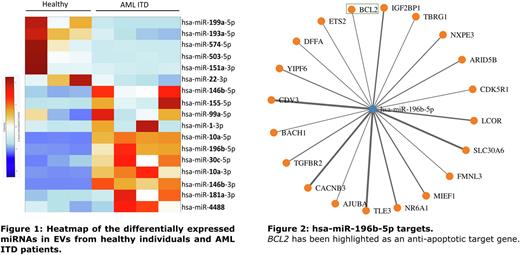Abstract
Introduction Intrinsic or acquired resistance to apoptosis is a hallmark of human cancers, including different subtypes of acute myeloid leukemia (AML). Among different mechanisms of achieving resistance, disposal of pro-apoptotic factors via extracellular vesicle (EV) release has been described for several cancer models. In AML, RNA and protein trafficking by leukemia-derived EVs has emerged as a mediator of cell-cell communication and a crucial factor in reprogramming the bone marrow (BM) niche into a leukemia permissive microenvironment. In our study, we aimed to characterize the content of primary AML-derived EVs with a special focus on apoptotic factors, and to evaluate the effect of EV release inhibition with FTY720, a FDA approved oral drug for treatment of multiple sclerosis, on apoptosis in combination with venetoclax (VEN) treatment, an inhibitor of the anti-apoptotic protein Bcl-2.
Methods BM-derived EVs were purified from healthy donors (n=3), or patients with newly diagnosed AML (FLT3-WT and -ITD, n=10) after written informed consent and approval by the ethics committee in accordance with the Declaration of Helsinki. EVs were characterized by transmission electron microscopy (TEM), western blotting and nano tracking analysis (NTA). Protein and RNA from EVs were isolated and used for proteomic and RNA analyses. The apoptotic response of FLT3-WT (OCI-AML2, OCI-AML3) or FLT3-ITD (MOLM-13, MV4-11) AML cell lines and primary samples to EV release inhibitor FTY720 was assessed by flow cytometry with AnnexinV/PI. FTY720-induced EV release inhibition and intracellular EV accumulation was determined by Western Blot analysis of EV markers and visualized by immunostaining. Finally, the combination treatment of FTY720 with VEN was tested.
Results TEM and immunoblotting confirmed a pure vesicle fraction (30-150 nm) with expression of characteristic markers enriched (CD63, CD81, HSP70) or absent (GAPDH, ß-actin) in EVs. NTA showed no differences in EV numbers released by AML compared to healthy cells. However, AML EVs were significantly larger in size. EV content was significantly different comparing healthy to AML-derived EVs and bioinformatic analysis from RNA sequencing revealed enrichment in pathways involved in regulation of apoptosis specifically in AML FLT3-ITD EVs (Figure 1). Of note, hsa-miR-196b-5p target interaction analysis identified BCL-2 as an exemplary anti-apoptotic target gene (Figure 2). Concordantly, AML cell lines harboring FLT3-ITD showed higher sensitivity to the EV release inhibitor FTY720 compared to FLT3-WT (IC50 = 6.2µM, 6.6µM, 13.7µM and 10.2µM respectively for MOLM-13, MV4-11, OCI-AML2 and OCI-AML3). FTY720 treatment induced intracellular EV accumulation and modulated EV marker expression confirming its effect on the EV machinery. Interestingly, FTY720 co-treatment potentiated apoptosis induced by VEN alone in both FLT3-ITD cell lines while FTL3-WT cells were still resistant to VEN and healthy hematopoiesis was unaffected.
Conclusions Taken together, these results suggest that FLT3-ITD AML cells establish a protective mechanism against apoptosis by disposing of positive regulators of apoptosis via EV release. Preventing the disposal of the pro-apoptotic factors in combination with BCL-2 inhibition sensitizes AML FLT3-ITD cells to apoptosis. Additional evaluation in primary patient material and further studies to identify the factors responsible for sensitization to apoptosis upon EV release inhibition are ongoing.
Disclosures
Bassermann:BMS: Honoraria. Goetze:BMS: Honoraria; Servier: Honoraria; Abbvie: Honoraria.
Author notes
Asterisk with author names denotes non-ASH members.


